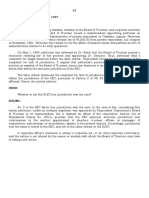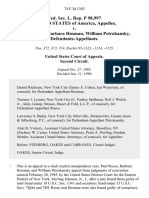Villena Vs NLRC
Villena Vs NLRC
Uploaded by
Kling KingCopyright:
Available Formats
Villena Vs NLRC
Villena Vs NLRC
Uploaded by
Kling KingOriginal Description:
Original Title
Copyright
Available Formats
Share this document
Did you find this document useful?
Is this content inappropriate?
Copyright:
Available Formats
Villena Vs NLRC
Villena Vs NLRC
Uploaded by
Kling KingCopyright:
Available Formats
453. SABAS B. VILLENA vs.
NLRC and BATANGAS, LAGUNA, TAYABAS BUS CO.
G.R. No. 90664 February 7, 1991
FACTS:
Sabas B. Villena started working with BLTBCo) as a bus conductor at the age of 25 yrs old. For 32
years he became traffic operations manager at the age of 57, directing the traffic operations with
three traffic supervisors under him. Villena's work required continuous service on the road from dawn
to dusk, hardly allowing him free time even on holidays.
On April 30, 1987, he received a letter advising that he was compulsorily retired from the service
effective immediately and was verbally advised to turn over his service vehicle, collect all his
belongings, and leave the company premises on the same day.
He meekly left the company premises and waited for advice regarding the "benefits" mentioned in
the letter which failed to mention how much he would receive.
On May 27, 1987, Villena's lawyer wrote the company a letter demanding clarification of the
terms of Villena's "retirement" from the service, and raising the point that the retrenchment of
personnel Under Philippine law, a company is required to give at least one (1) month notice to the
employee before the intended date of termination for this ground for separation while the notice of
termination was given to Mr. Villena only in the morning of April 30, 1987, the very same day his
termination was to take effect.
The company admitted its omission to serve the required notice of termination and offered to pay
P66,370.00 computed on the basis of Villena's salary to which the latter opposed claiming that
the basis for computing his benefits should be his gross compensation.
The LA ruled that his
ISSUE: WON the termination of Villena in the guise of "compulsory retirement," is valid notwithstanding
the lack of evidence to prove financial losses and prior notice.
HELD: NO.
While the law recognizes the right of an employer to dismiss an employee in justifiable cases, it
frowns upon the arbitrary and whimsical exercise of that prerogative when the employee's right to due
process is Violated. Business losses as a just cause for retrenchment, must be proved, for they can be
feigned.
While the purpose was allegedly to carry out a retrenchment program to cut losses, the legal
procedure for the retrenchment of personnel was not followed, to wit:
1) one-month prior notice to the employee as prescribed by law was not given (Art. 283, Labor
Code of the Philippines, as amended Sec. 5, Rule XIV, B.P. 130);
(2) no fair and reasonable criteria were used in carrying out the retrenchment program, such as
(a) less-preferred status (i.e., temporary employees), (b) efficiency rating, and (c) seniority
(3) no proof of the alleged financial losses suffered by the company was produced.
It appears, therefore, that the so-called "compulsory retirement" was a scheme employed by the
company to terminate Villena's employment without complying with the due process requirements of the
law and without regard for his right to security of tenure.
Such proof was wanting in this case. The "compulsory retirement" of Villena was in effect a
dismissal in violation of law.1âwphi1 He still had a full three years to serve the company when his
employment was peremptorily terminated by his employer. Having been illegally dismissed, he is entitled
to receive full compensation for the remaining three years of his work life. Upon reaching age sixty (60),
he may be retired and shall be entitled to receive the normal retirement benefits under the company's
applicable bona-fide retirement plan or established company policy, or, in the absence thereof, as
provided in Section 14, Book VI of the Implementing Regulations to the labor Code
You might also like
- Motion To Discharge AttachmentDocument4 pagesMotion To Discharge AttachmentCzarina RubicaNo ratings yet
- Corporation SoleDocument30 pagesCorporation SoleJulian Williams©™100% (8)
- Megascope V NLRC DigestDocument1 pageMegascope V NLRC DigestLaurence Brian HagutinNo ratings yet
- Borromeo Vs Family CareDocument2 pagesBorromeo Vs Family CareKling KingNo ratings yet
- People Vs Allen MantalabaDocument1 pagePeople Vs Allen MantalabaKling KingNo ratings yet
- Emma - Asian Design and Manufacturing Corp V CallejaDocument2 pagesEmma - Asian Design and Manufacturing Corp V CallejaEmma GuancoNo ratings yet
- Almagro Vs Sps AmayaDocument15 pagesAlmagro Vs Sps AmayabrigetteNo ratings yet
- Cruzvale vs. LaguesmaDocument2 pagesCruzvale vs. LaguesmaJevi RuiizNo ratings yet
- Asian Design and Manufacturing Corporation VsDocument4 pagesAsian Design and Manufacturing Corporation VsAllen Windel BernabeNo ratings yet
- 131 - Maranaw Hotel Resort Corp Vs NLRCDocument1 page131 - Maranaw Hotel Resort Corp Vs NLRCKornessa ParasNo ratings yet
- Dealco Farms DigestDocument2 pagesDealco Farms DigestkarlonovNo ratings yet
- 14 Remerco Garments Mfg. v. Minister of LaborDocument4 pages14 Remerco Garments Mfg. v. Minister of LaborlorenbeatulalianNo ratings yet
- Sunace V NLRCDocument11 pagesSunace V NLRCReihannah Paguital-MagnoNo ratings yet
- Cagampan Vs NLRCDocument1 pageCagampan Vs NLRCShally Lao-unNo ratings yet
- DM Consunji Inc., v. EstelitoDocument1 pageDM Consunji Inc., v. EstelitoRaiza SunggayNo ratings yet
- Stolt-Nielsen Marine Services (Phils.), Inc. vs. NLRC, 264 SCRA 307, November 19, 1996. FactsDocument1 pageStolt-Nielsen Marine Services (Phils.), Inc. vs. NLRC, 264 SCRA 307, November 19, 1996. FactsYori AvilaNo ratings yet
- Industrial Timber Vs NLRCDocument6 pagesIndustrial Timber Vs NLRCHeidiNo ratings yet
- Hanjin Heavy Industries v. IbanezDocument2 pagesHanjin Heavy Industries v. IbanezDorothy Ann De La Pena100% (1)
- Periquet vs. NLRCDocument5 pagesPeriquet vs. NLRCJasper PelayoNo ratings yet
- Imbuido v. National Labor Relations Commission, 385 Phil. 999, 1013 (2000)Document4 pagesImbuido v. National Labor Relations Commission, 385 Phil. 999, 1013 (2000)Daniela Sandra AgootNo ratings yet
- SIY v. TOMLIN-WPS OfficeDocument1 pageSIY v. TOMLIN-WPS OfficeRafael Francesco GonzalesNo ratings yet
- Golden Thread Knitting Vs NLRCDocument1 pageGolden Thread Knitting Vs NLRCGale Charm SeñerezNo ratings yet
- Rcpi Vs NLRCDocument4 pagesRcpi Vs NLRCjovani emaNo ratings yet
- Emeritus Security & Maintenance Systems Inc., vs. DailigDocument2 pagesEmeritus Security & Maintenance Systems Inc., vs. DailigNej AdunayNo ratings yet
- People v. Abordo (Art. 13 - Illegal Recruitment)Document15 pagesPeople v. Abordo (Art. 13 - Illegal Recruitment)Ching ApostolNo ratings yet
- Ricardo E. Vergara, JR., Petitioner, V. Coca-Cola Bottlers PhilippinesDocument4 pagesRicardo E. Vergara, JR., Petitioner, V. Coca-Cola Bottlers PhilippinesEmanuelle EyanaNo ratings yet
- 25 - AASJS Vs DatumanongDocument2 pages25 - AASJS Vs DatumanongPatrick ManaloNo ratings yet
- People V Ochoa CompressDocument3 pagesPeople V Ochoa CompressElyn ApiadoNo ratings yet
- Cadalin Et Al VsDocument62 pagesCadalin Et Al VsJil Mei IVNo ratings yet
- Labor Notes (Pre-Employment)Document11 pagesLabor Notes (Pre-Employment)Glyza Kaye Zorilla PatiagNo ratings yet
- Mabeza Vs NLRCDocument2 pagesMabeza Vs NLRCCeledonio ManubagNo ratings yet
- G.R. No. L-87672 Wise Vs WiseDocument2 pagesG.R. No. L-87672 Wise Vs WiseBreth1979No ratings yet
- Maternity Children's Hospital v. Sec of LaborDocument2 pagesMaternity Children's Hospital v. Sec of LaborRochelle Joy SolisNo ratings yet
- Labor Cases 4 Tranche: Post Employment Case No. 15 Aurora Land Projects Corp. v. NLRCDocument1 pageLabor Cases 4 Tranche: Post Employment Case No. 15 Aurora Land Projects Corp. v. NLRCMae Clare BendoNo ratings yet
- G.R. NO. 164774 Star Paper Vs SimbolDocument12 pagesG.R. NO. 164774 Star Paper Vs SimbolLala ReyesNo ratings yet
- Santos V NLRC 287 SCRA 117Document2 pagesSantos V NLRC 287 SCRA 117Jing DalaganNo ratings yet
- NESTLE PHILIPPINES v. NLRCDocument2 pagesNESTLE PHILIPPINES v. NLRCGabriel LiteralNo ratings yet
- People v. de Los ReyesDocument2 pagesPeople v. de Los ReyesElaine Belle OgayonNo ratings yet
- Philtread Workers Union vs. ConfessorDocument2 pagesPhiltread Workers Union vs. Confessorjovani emaNo ratings yet
- Ditan Vs POEADocument3 pagesDitan Vs POEAJiHahn PierceNo ratings yet
- 232 PAL V SOLEDocument2 pages232 PAL V SOLEFrancis MasiglatNo ratings yet
- Legal Ethics 2nd Exam CompilationDocument11 pagesLegal Ethics 2nd Exam CompilationTin CaddauanNo ratings yet
- Lazaro Vs Social Security CommissionDocument1 pageLazaro Vs Social Security CommissionMarinelle Aycee Moleta PerralNo ratings yet
- Aguilar VS NLRCDocument2 pagesAguilar VS NLRCRochelle Othin Odsinada MarquesesNo ratings yet
- M.Y. San Biscuits, Inc. vs. Laguesma G.R. 95011 - April 22, 1991Document1 pageM.Y. San Biscuits, Inc. vs. Laguesma G.R. 95011 - April 22, 1991Praisah Marjorey PicotNo ratings yet
- Holiday Inn Manila v. NLRCDocument2 pagesHoliday Inn Manila v. NLRCMekiNo ratings yet
- Sameer Overseas Placement Agency VsDocument2 pagesSameer Overseas Placement Agency VsBikoy EstoqueNo ratings yet
- #7 Tabang Vs NLRC G.R. No. 121143, January 21, 1997 FactsDocument1 page#7 Tabang Vs NLRC G.R. No. 121143, January 21, 1997 FactsPNP MayoyaoNo ratings yet
- Philippine Marine Officers Guild V Cia. MaritimaDocument5 pagesPhilippine Marine Officers Guild V Cia. MaritimaAlexis Ailex Villamor Jr.No ratings yet
- Baliwag Transit, Inc. V OpleDocument14 pagesBaliwag Transit, Inc. V OpleSeffirion69No ratings yet
- Militante Vs NLRCDocument1 pageMilitante Vs NLRCjohnmiggyNo ratings yet
- Labor Review CasesDocument8 pagesLabor Review CasesRijane CantanillaNo ratings yet
- B.14 Pines V NLRCDocument13 pagesB.14 Pines V NLRCAprilMartelNo ratings yet
- 10-Spouses Soller v. Singson20220404-13-1bctkffDocument5 pages10-Spouses Soller v. Singson20220404-13-1bctkffBernadith RectoNo ratings yet
- Maula vs. Ximex, GR No. 207838, January 25, 2017Document1 pageMaula vs. Ximex, GR No. 207838, January 25, 2017Affle John Leonor100% (1)
- 53 - Caro V RillorazaDocument2 pages53 - Caro V RillorazaFelix Gerard Jr. LeysonNo ratings yet
- Midterms LaborDocument4 pagesMidterms LaborDonnie Ray SolonNo ratings yet
- Dumpit-Murillo vs. CADocument2 pagesDumpit-Murillo vs. CABert NazarioNo ratings yet
- Ma. Finina E. Vicente Petitioner v. CA, Former Seventeenth Division and Cinderella Marketing Corporation, Respondents.Document2 pagesMa. Finina E. Vicente Petitioner v. CA, Former Seventeenth Division and Cinderella Marketing Corporation, Respondents.Gela Bea BarriosNo ratings yet
- Cebu People's Multi-Purpose Cooperative v. Carbonilla, JRDocument3 pagesCebu People's Multi-Purpose Cooperative v. Carbonilla, JR8s7k97vpwvNo ratings yet
- Labor Case Digest (Nov 21, 2023)Document16 pagesLabor Case Digest (Nov 21, 2023)Pamela Jane I. TornoNo ratings yet
- Arco Metal Products Inc. V. Samahan NG Mga Manggagawa Sa Arco Metal - NafluDocument1 pageArco Metal Products Inc. V. Samahan NG Mga Manggagawa Sa Arco Metal - Naflubenbongon31No ratings yet
- Cases - Assigned - 3rdDocument2 pagesCases - Assigned - 3rdjanine nenariaNo ratings yet
- Article 285 of The Labor Code of The PhilippinesDocument2 pagesArticle 285 of The Labor Code of The PhilippinesMaybelle100% (1)
- Arafiles Vs Phil. JournalilstsDocument1 pageArafiles Vs Phil. JournalilstsKling KingNo ratings yet
- People vs. TionlocDocument1 pagePeople vs. TionlocKling King100% (1)
- Pinlac VS PeopleDocument1 pagePinlac VS PeopleKling KingNo ratings yet
- .Afialda V. Hisole Case DigestDocument1 page.Afialda V. Hisole Case DigestKling KingNo ratings yet
- Anonuevo Vs CADocument1 pageAnonuevo Vs CAKling KingNo ratings yet
- Lichauco VS Figueras HermanosDocument2 pagesLichauco VS Figueras HermanosKling KingNo ratings yet
- Cagayan Vs RapananDocument4 pagesCagayan Vs RapananKling KingNo ratings yet
- Villamor Vs Comelec and AmytisDocument6 pagesVillamor Vs Comelec and AmytisKling KingNo ratings yet
- Albenson Vs CADocument2 pagesAlbenson Vs CAKling KingNo ratings yet
- Amonoy Vs GutierezDocument1 pageAmonoy Vs GutierezKling KingNo ratings yet
- BJDC CONSTRUCTION Vs LANUZODocument5 pagesBJDC CONSTRUCTION Vs LANUZOKling KingNo ratings yet
- BERNARDO Vs LegaspiDocument2 pagesBERNARDO Vs LegaspiKling KingNo ratings yet
- Export Processing Zone Authority vs. CHRDocument1 pageExport Processing Zone Authority vs. CHRKling KingNo ratings yet
- Columbia Vs CADocument2 pagesColumbia Vs CAKling King100% (1)
- DANDY L. DUNGO and GREGORIO A. SIBAL, JR., Vs PeopleDocument3 pagesDANDY L. DUNGO and GREGORIO A. SIBAL, JR., Vs PeopleKling KingNo ratings yet
- Barrientos VS DaarolDocument3 pagesBarrientos VS DaarolKling KingNo ratings yet
- Batistis vs. PeopleDocument1 pageBatistis vs. PeopleKling KingNo ratings yet
- People Vs Nang KayDocument1 pagePeople Vs Nang KayKling KingNo ratings yet
- People Vs GiveraDocument1 pagePeople Vs GiveraKling King100% (1)
- In Re Habeas Corpus of Datukan Malang Salibo DigestDocument2 pagesIn Re Habeas Corpus of Datukan Malang Salibo DigestKling KingNo ratings yet
- FIGUEROA-VS-PEOPLE Rule 16Document2 pagesFIGUEROA-VS-PEOPLE Rule 16Kling King100% (1)
- Agrarian Law - Tenancy Relationship RequisitesDocument33 pagesAgrarian Law - Tenancy Relationship RequisitesKling KingNo ratings yet
- People vs. FigueroaDocument2 pagesPeople vs. FigueroaKling King100% (2)
- G.R. No. 198450 People vs. Fernando Ranche Havana A.K.A. Fernamdo Ranche AbanaDocument2 pagesG.R. No. 198450 People vs. Fernando Ranche Havana A.K.A. Fernamdo Ranche AbanaKling King100% (1)
- Wellex Group vs. SandiganbayanDocument3 pagesWellex Group vs. SandiganbayanKling KingNo ratings yet
- Labor DigestDocument43 pagesLabor DigestKling KingNo ratings yet
- Pablo Francisco Vs CADocument2 pagesPablo Francisco Vs CAKling King100% (1)
- NYCourts IntroGuideDocument18 pagesNYCourts IntroGuidewingandaprayerNo ratings yet
- NUEVA ECIJA II ELECTRIC COOPERATIVE Vs MAPALGUDocument2 pagesNUEVA ECIJA II ELECTRIC COOPERATIVE Vs MAPALGUCamille Grace100% (1)
- Agreement: Terms & Conditions of AgreementDocument2 pagesAgreement: Terms & Conditions of AgreementamanatbuttNo ratings yet
- Teacher Arrested Rape of PupilDocument2 pagesTeacher Arrested Rape of PupilJoannamia CuadraNo ratings yet
- Consti 2 Equal ProtectionDocument8 pagesConsti 2 Equal ProtectionKim Jan Navata BatecanNo ratings yet
- 2 Pre ImmersionDocument9 pages2 Pre ImmersionXyrel Kim FernandezNo ratings yet
- Refugee LawDocument30 pagesRefugee Lawaakash94No ratings yet
- Pfrdigest - Republic Vs Coseteng-Magpayo, G.R. No. 189476, February 2, 2012 FactsDocument3 pagesPfrdigest - Republic Vs Coseteng-Magpayo, G.R. No. 189476, February 2, 2012 FactsLu CasNo ratings yet
- Fed. Sec. L. Rep. P 98,997 United States of America v. Paul Russo, Barbara Hosman, William Petrokansky, 74 F.3d 1383, 2d Cir. (1996)Document20 pagesFed. Sec. L. Rep. P 98,997 United States of America v. Paul Russo, Barbara Hosman, William Petrokansky, 74 F.3d 1383, 2d Cir. (1996)Scribd Government DocsNo ratings yet
- C52 Yu Vs Hon. Rosa Samson-TatadDocument1 pageC52 Yu Vs Hon. Rosa Samson-TatadRene GomezNo ratings yet
- Ferrell7ce PPT Ch02Document27 pagesFerrell7ce PPT Ch02sukhpreet singhNo ratings yet
- Shankar Kisanrao Khade Vs State of Maharashtra On 25 April, 2013 PDFDocument47 pagesShankar Kisanrao Khade Vs State of Maharashtra On 25 April, 2013 PDFmkkhortiNo ratings yet
- Motion Rey CheongDocument2 pagesMotion Rey CheongRoman DelaTorreNo ratings yet
- Case Digest - Civpro2016Document22 pagesCase Digest - Civpro2016Alyssa Clarizze MalaluanNo ratings yet
- Maintainability of Review Petition in Supreme CourtDocument1 pageMaintainability of Review Petition in Supreme CourtSaurabh AnandNo ratings yet
- 1 g11 U1 Voc Get Lang Look - Print QuizizzDocument6 pages1 g11 U1 Voc Get Lang Look - Print QuizizzLe le ThiNo ratings yet
- Ra 11210 Expanded Maternity LeaveDocument7 pagesRa 11210 Expanded Maternity LeaveBok CoolNo ratings yet
- COMELEC v. CruzDocument13 pagesCOMELEC v. CruzJD greyNo ratings yet
- School Forms Spread SheetDocument148 pagesSchool Forms Spread SheetBTS ArmyNo ratings yet
- GabrielarizosDocument2 pagesGabrielarizosapi-430719410No ratings yet
- Gauri Shanker Vs Union of India On 8 September, 1994Document7 pagesGauri Shanker Vs Union of India On 8 September, 1994Dhilip RoshanNo ratings yet
- Moot Proposition: 1 National Online Moot Court Competition 2020Document5 pagesMoot Proposition: 1 National Online Moot Court Competition 2020Saransh BhardwajNo ratings yet
- Salary Grade Gov T Employee 2012Document1 pageSalary Grade Gov T Employee 2012Harby Ongbay AbellanosaNo ratings yet
- CADocument6 pagesCADarwin ViadumangNo ratings yet
- Fair Use, Fair Dealing and Other Open Ended Exceptions: The Application of The Three Step TestDocument22 pagesFair Use, Fair Dealing and Other Open Ended Exceptions: The Application of The Three Step TestChintakayala SaikrishnaNo ratings yet
- Rodipet DecizieDocument136 pagesRodipet DecizieAR GameCenterNo ratings yet
- Jerome Daly CaseDocument5 pagesJerome Daly Casecomputax53No ratings yet
- Ken Biegeleisen v. Mary Ross and Kim Albert, 158 F.3d 59, 2d Cir. (1998)Document3 pagesKen Biegeleisen v. Mary Ross and Kim Albert, 158 F.3d 59, 2d Cir. (1998)Scribd Government DocsNo ratings yet






















































































































